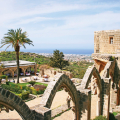BELLAPAÏS ABBEY
Former French Catholic abbey. Magnificent Gothic ruins and breathtaking coastal views. Not to be missed.
This former French Catholic abbey (Bellapais Manastırı, Αββαείο Μπελαπάις/Avvaeo Belapaïs) is Cyprus' most romantic monument. Overlooking Kyrenia, 220 m above sea level, its magnificent 13th-century Gothic ruins offer a grandiose panorama of the sea and the verdant surrounding villages.
Grandeur and decadence. In the 7th century, the site may have served as a refuge for Byzantine bishops fleeing Arab raids. But the first to settle here permanently were the Catholic knights of the Order of the Holy Sepulchre, after the capture of Jerusalem by Saladin in 1187. It was for these Augustinian soldier-monks that Amaury II de Lusignan, King of Cyprus, founded the abbey around 1198-1205 under the name of Notre-Dame de la Montagne. In 1206, however, the site was entrusted to the Premonstratensian order of canons from Laon (Picardy), who also followed the rule of Saint Augustine. For a long time, the monastery was known as the "white abbey", in reference to the way the monks dressed. Its renown was assured by a donation in 1246 from the knight Roger Normand: a treasure left over from the sacking of Constantinople by the Crusaders in 1204. This Norman lord of Sicily gave the abbey 600 Byzantine gold coins and, above all, a supposed relic of the True Cross, on which Christ was put to death. Pilgrims flock to the abbey. To capitalize on this windfall and the abbey's prestige, the Lusignans appointed themselves abbots. The buildings we see today date from this period: between 1267 and 1284, Hugues III of Cyprus had the church and dormitory built, followed by Hugues IV, the cloister, refectory and his own apartments (1324-1359). In 1373, the abbey was pillaged by the Genoese. A long decline began. The complex was abandoned by the Lusignans. After the island was taken by the Venetians in 1489, a small community of monks remained, with increasingly relaxed morals: women were tolerated, then moved in; witnesses mention polygamy and novices chosen from among the boys born of these unions. This "tolerant" attitude led to the site being called abaie lapais ("abbey of peace" in Old French). This later became bella paese in Italian, to evoke the "beautiful landscapes" of the surrounding area, and finally Bellapaïs. After the Ottoman conquest (1571), the monastery was entrusted to the Cypriot Orthodox clergy. But they lost interest in it. The abbey church was used as a parish church and the outbuildings as a quarry. It was not until the end of the 19th century that the first conservation measures were taken by the British. In the early days of the 1974 invasion, Kyrenia's hospital was transferred here. A year later, the last Orthodox priest was expelled from Bellapais.
Visit The abbey retains five buildings: church (south), cloister (center), refectory (north), dormitory and chapter house (east). Today, the Kybele restaurant stands on the site of the former warehouses (west). The church has undergone few changes since its consecration around 1280. Its Greek name recalls the white abbey of the Premonstratensians: Panagia Asproforousa, "Virgin of the White Robe". 27 m long and 11 m high, the abbey church is dominated by a bell tower with four openings, where only one bell remains. Inside, the beautiful pointed vaults are reminiscent of some 12th-century French churches. The simplicity of the architecture reveals the influence of the Cîteaux order: a narthex, a two-bay nave with a non-projecting transept that extends into an apse. Ornamentation is rare and later: a finely sculpted pulpit (14th century), Italian frescoes in the porch (15th century). Orthodox elements include a carved wooden iconostasis (1884). But the most precious icons (17th century) are in the Byzantine Museum in Nicosia. The cloister, built later (mid-13th century), bears witness to the "radiating Gothic" style, with its arches and finely-crafted railings. Note the Roman sarcophagus in carved marble (3rd century), which served as a washbasin for the monks. The eighteen arches have been preserved, but the west gallery was demolished in the 17th century, along with the cellarium (warehouse). The refectory, a vast building (30 x 10 m), is the best preserved, with its finely-worked projecting pulpit and rose window, its six intact vaults and six windows offering a completely unobstructed view of the coast. Above the doorway are three carved coats of arms: the lion of the Lusignans, the cross of the kings of Jerusalem and the two previous elements combined to form the arms of the kingdom of Cyprus. In the dormitory (20 x 8.5 m), the formerly plastered stones reveal the marks of the workmen who cut them: some in the shape of an N, others close to a K, still others evoking the cross of the Knights of Jerusalem, then combinations with more elaborate spellings. These marks were used to quantify the work of the carvers, in order to pay them. Finally, the chapter house (8.5 x 8.5 m) is located in the southern extension of the dormitory. It was here that decisions concerning the monastic community were taken. A passageway provided access to the crypt's workshops and the church's sacristy. In the center, a Byzantine marble column supports eight arches.
Did you know? This review was written by our professional authors.
Book the Best Activities with Get Your Guide
Members' reviews on BELLAPAÏS ABBEY
The ratings and reviews below reflect the subjective opinions of members and not the opinion of The Little Witty.


Ce n'est pas le plus beau site que j'ai fait durant mon voyage.
La visite est assez rapide, je vous conseil de le faire en fin de matinée comme ça vous pouvez profiter des nombreux resto du village.
Dans un village typique et fort agréable il y avait une abbaye qui au fil du temps a subi quelques dégâts. Mais ce qu'il en reste est magnifique: la cathédrale, les espaces du monastères ont été très bien restaurés. C'est super!!!......